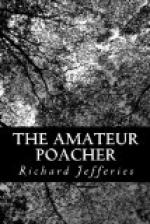Now a hare coming from the uplands beyond the woods, or from the woods, and desirous of visiting the cornfields of the level grounds below, found it difficult to pass the water. For besides the marsh itself, the mere, and the brook, another slow, stagnant stream, quite choked with sedges and flags, uncut for years, ran into it, or rather joined it, and before doing so meandered along the very foot of the hill-side over which the woods grew. To a hare or a rabbit, therefore, there was but one path or exit without taking to the water in this direction for nearly a mile, and that was across this narrow raised causeway. The pheasants frequently used it, as if preferring to walk than to fly. Partridges came too, to seat themselves in the dry dust—a thing they do daily in warm weather.
Hares were constantly passing from the cornfields to the wood, and the wood to the cornfields; and they had another reason for using this track, because so many herbs and plants, whose leaves they like better than grass, flourished at the sides of the hedges. No scythe cuts them down, as it does by the hedges in the meadows; nor was a man sent round with a reaping hook to chop them off, as is often done round the arable fields. There was, therefore, always a feast here, to which, also, the rabbits came.
The poachers were perfectly well aware of all this, and as a consequence this narrow lane became a most favourite haunt of theirs. A wire set in the runs that led to the causeway, or in the causeway itself, was almost certain to be thrown. At one time it was occasionally netted; and now and then a bolder fellow hid himself in the bushes with a gun, and took his choice of pheasant, partridge, hare, or rabbit. These practices were possible, because although so secluded, there was a public right-of-way along the lane.
But of recent years, as game became more valued and the keepers were increased, a check was put upon it, though even now wires are frequently found which poachers have been obliged to abandon. They are loth to give up a place that has a kind of poaching reputation. As if in revenge for the interference, they have so ransacked the marsh every spring for the eggs of the waterfowl that the wild duck will not lay there, but seek spots safer from such enemies. The marsh is left to the coots and moorhens that from thence stock the brooks.
CHAPTER X
FARMER WILLUM’S PLACE: SNIPE SHOOTING
One October morning towards the end of the month, Orion and I started to beat over Redcote Farm upon the standing invitation of the occupier. There was a certainty of sport of some kind, because the place had remained almost unchanged for the last century. It is ‘improvement’ that drives away game and necessitates the pheasant preserve.
The low whitewashed walls of the house were of a dull yellowish hue from the beating of the weather. They supported a vast breadth of thatched roof drilled by sparrows and starlings. Under the eaves the swallows’ nests adhered, and projecting shelves were fixed to prevent any inconvenience from them. Some of the narrow windows were still darkened with the black boarding put up in the days of the window tax.




